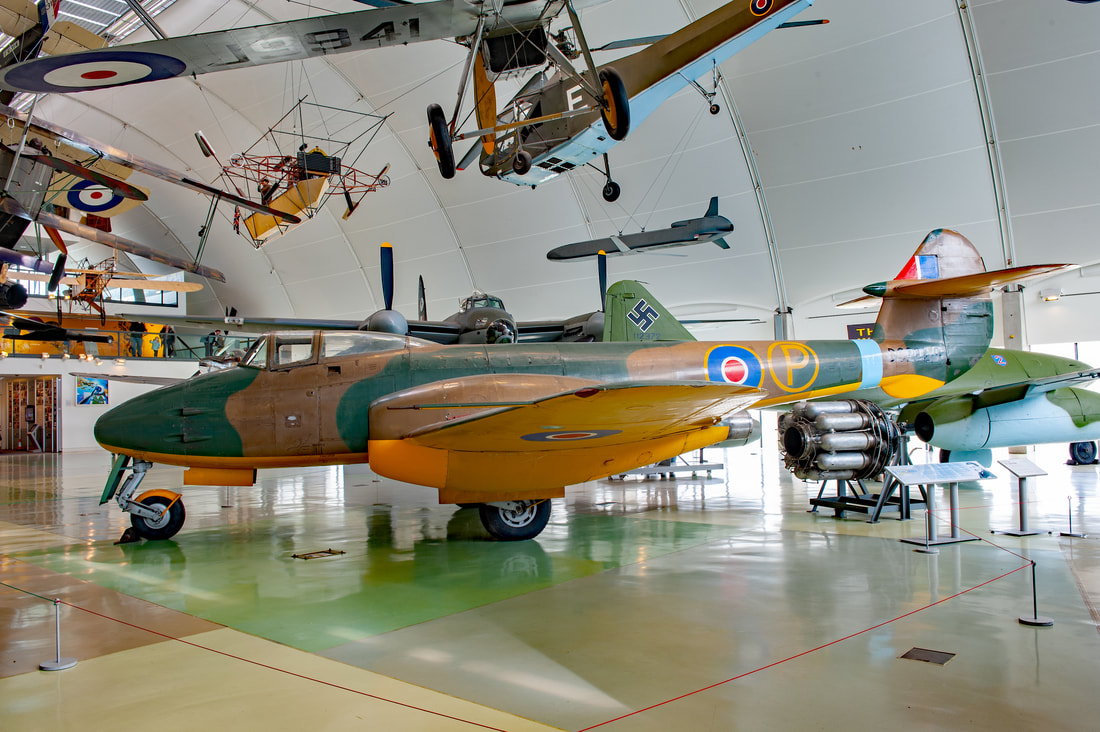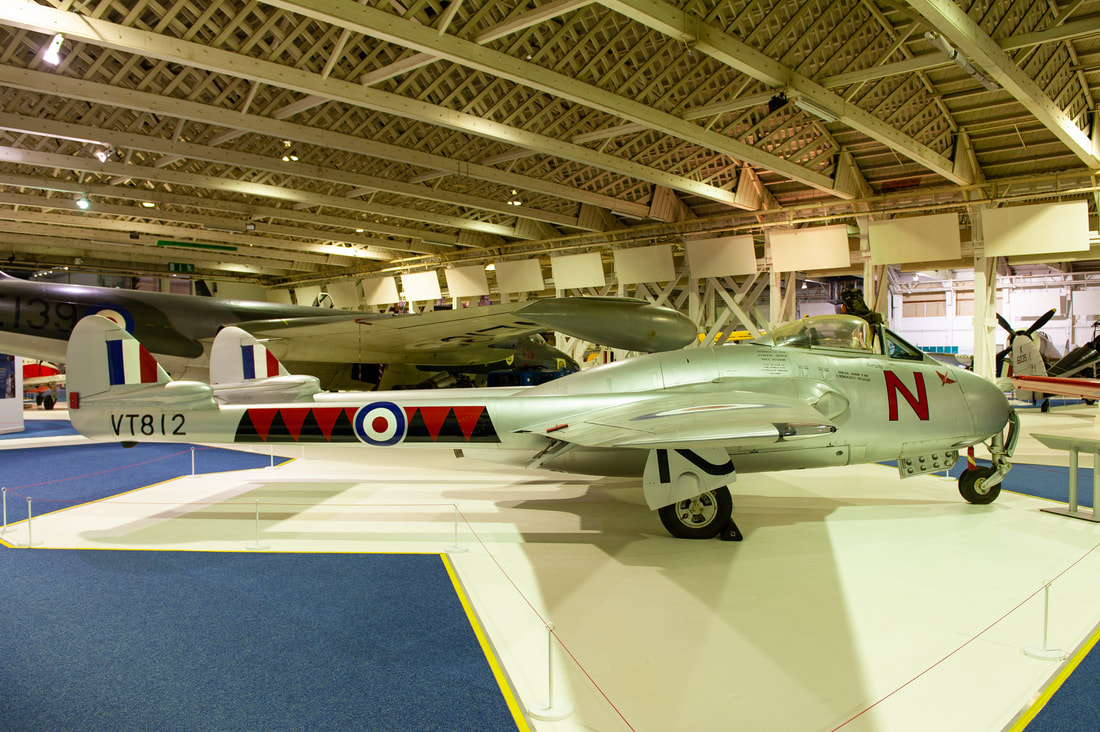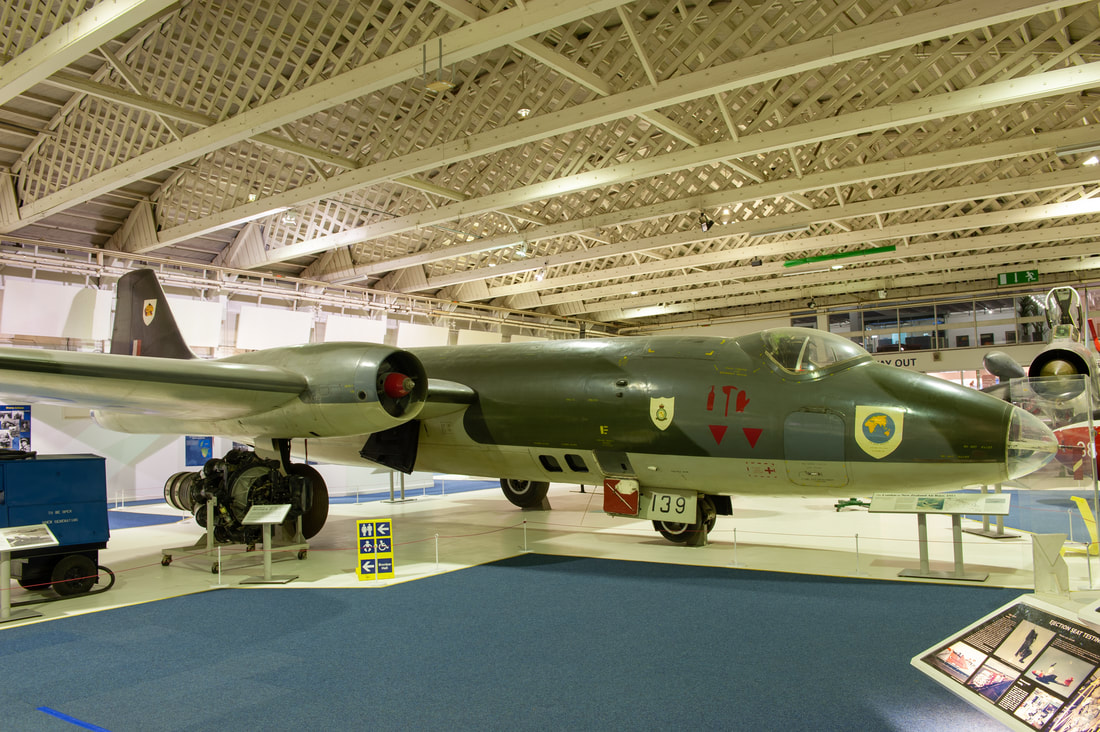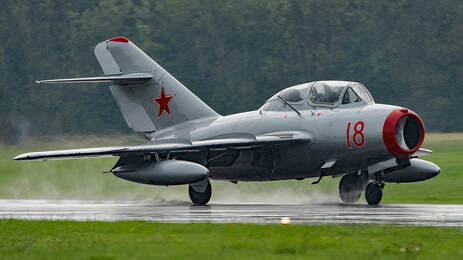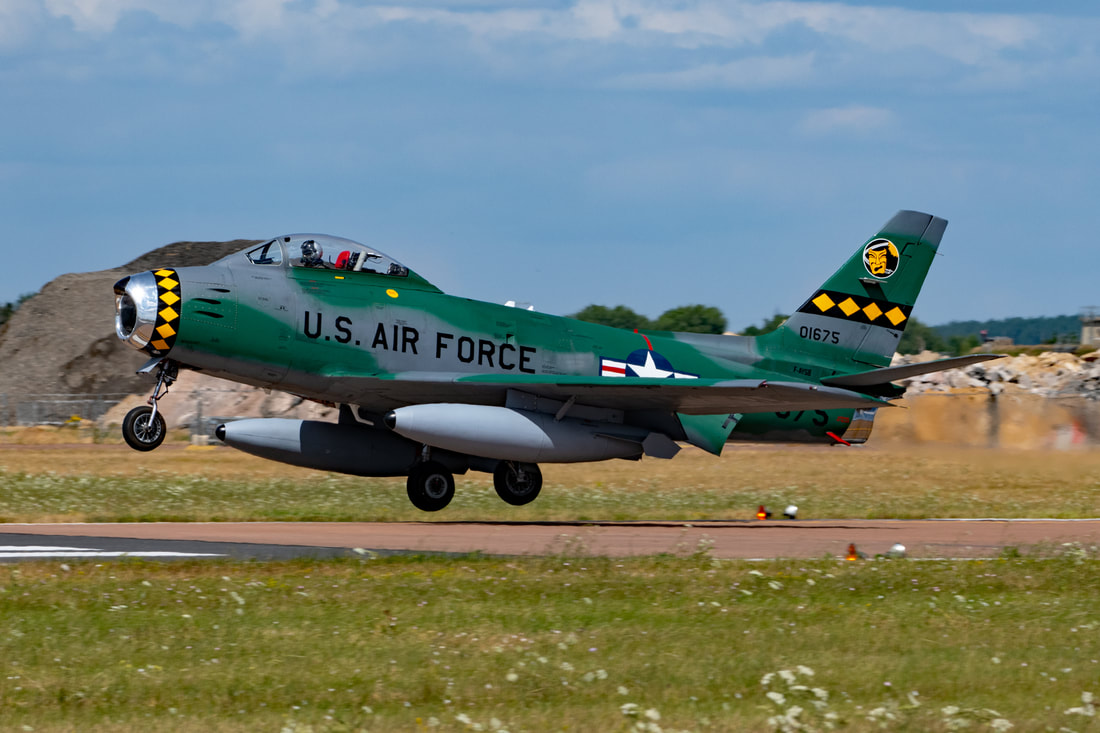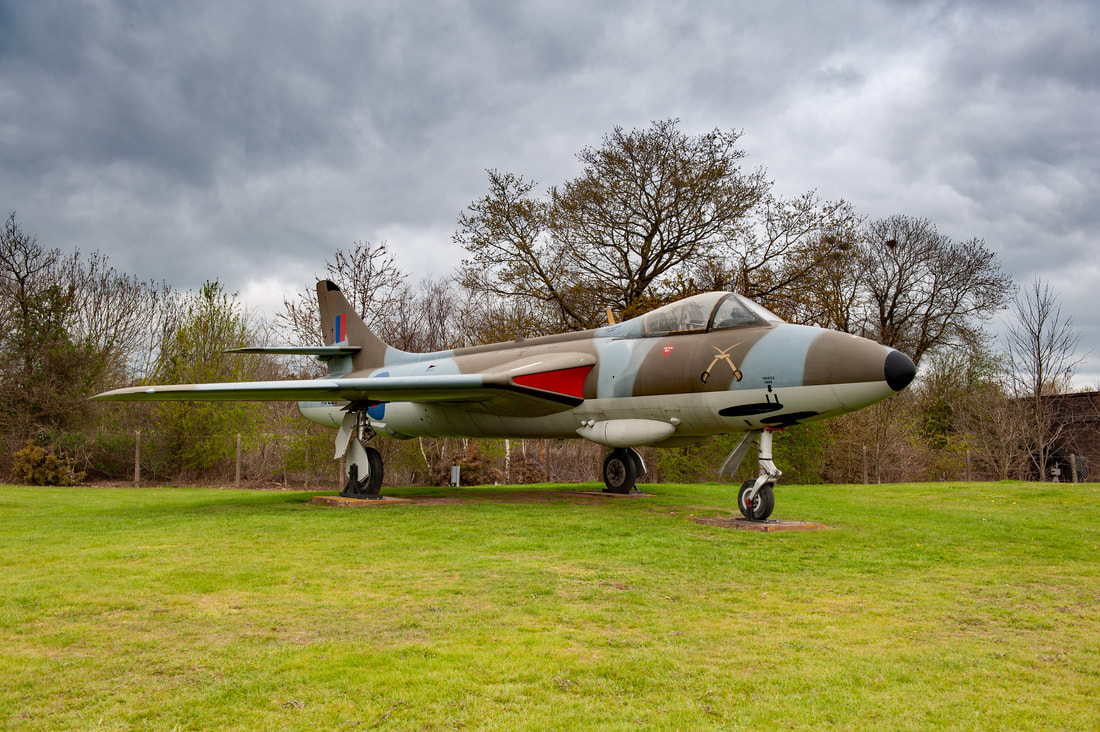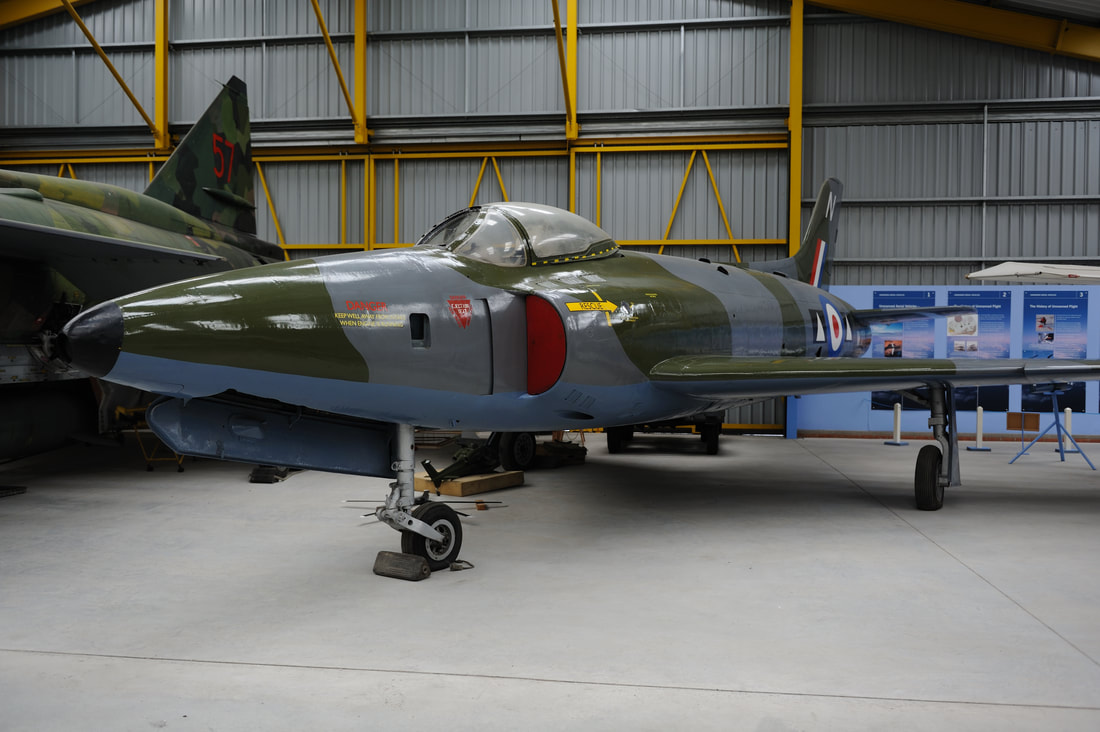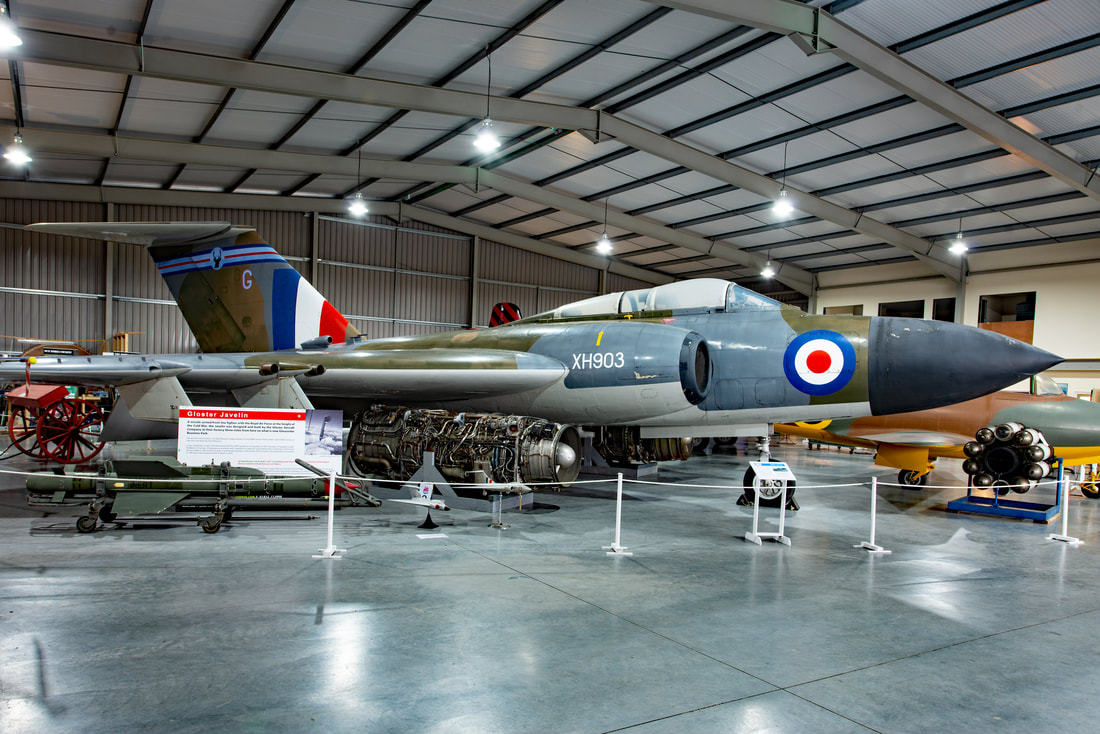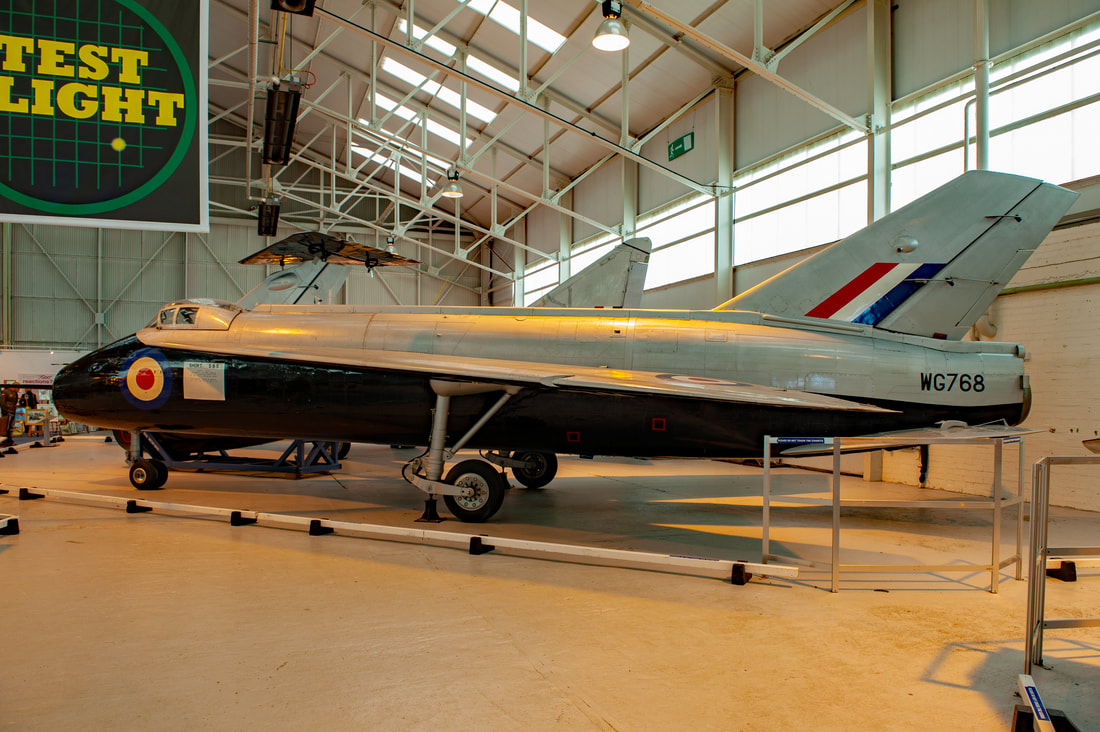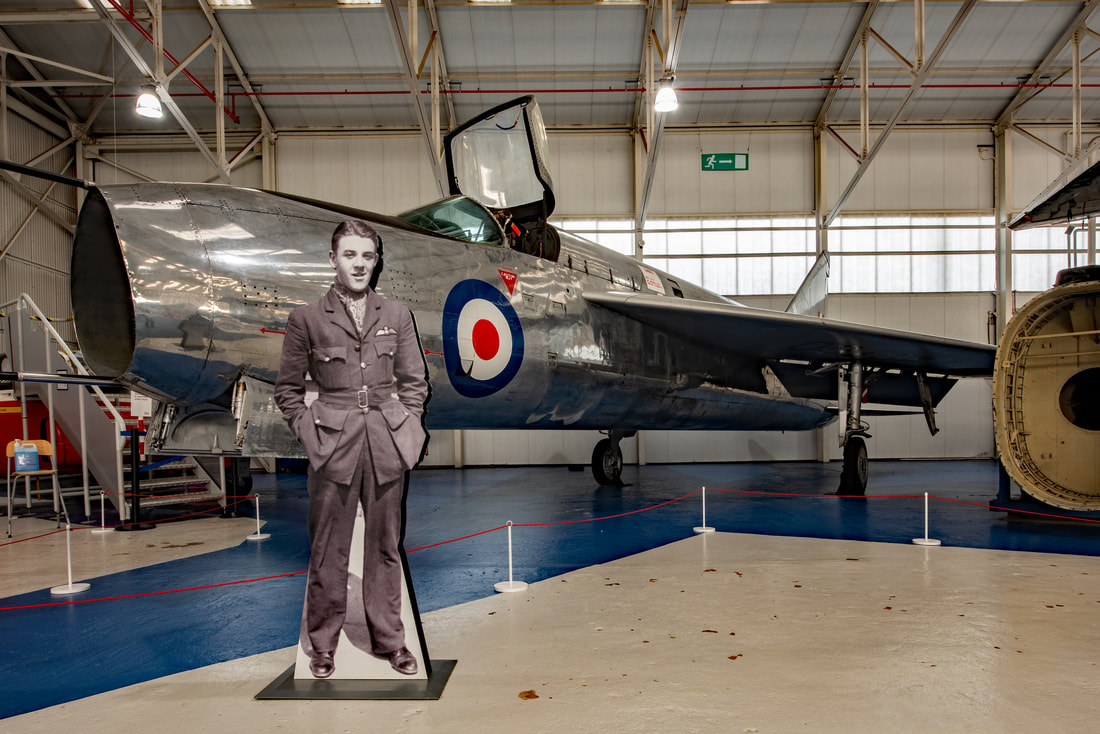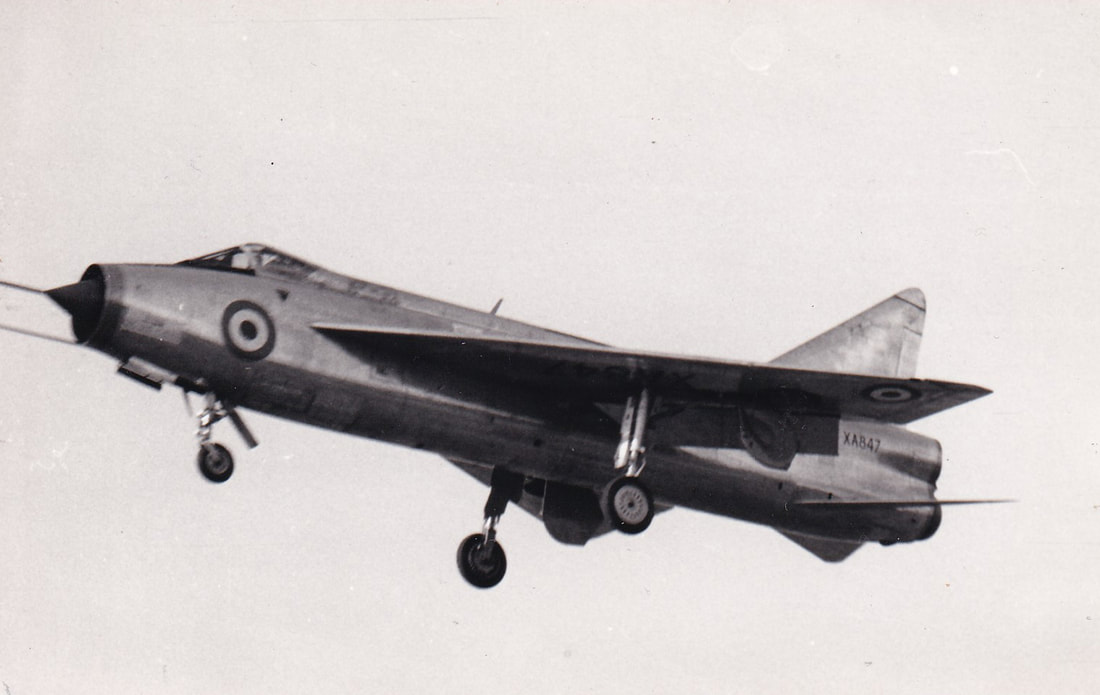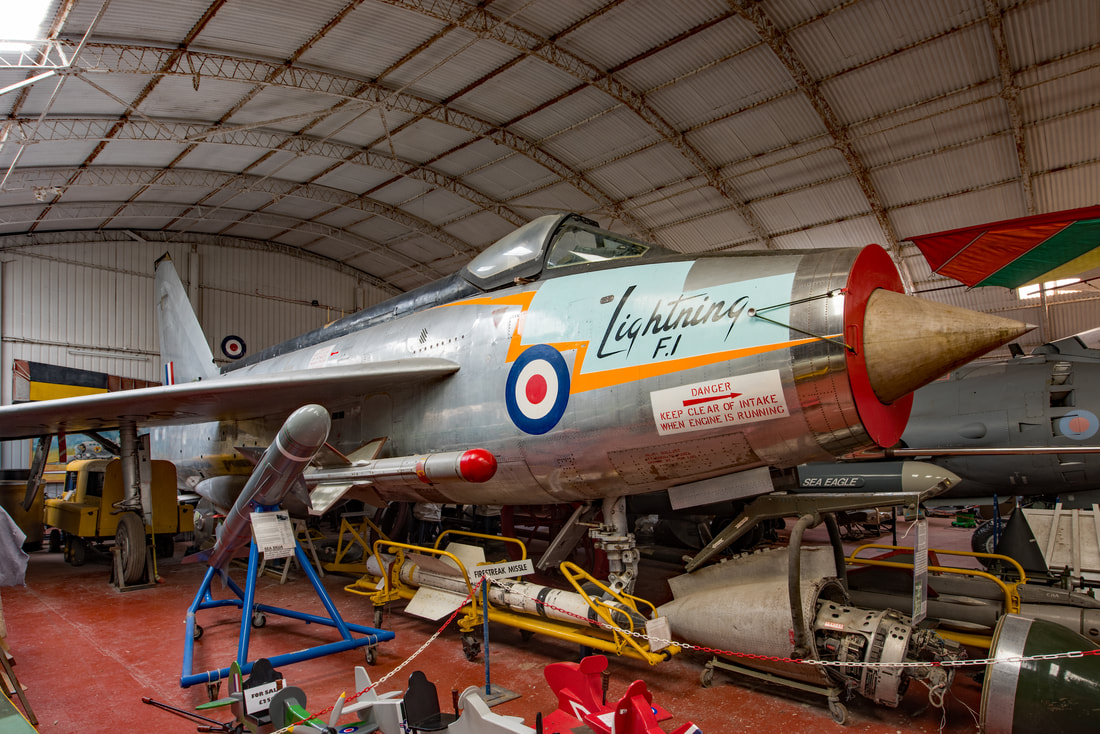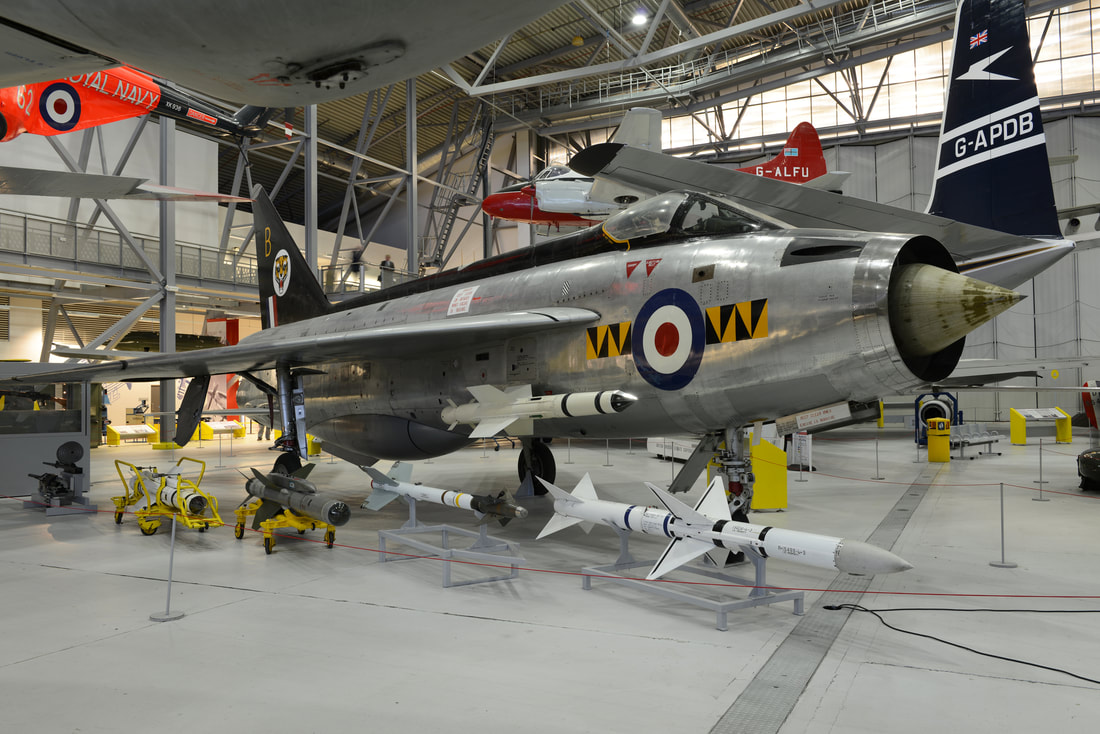Lightning Design and Development
Written by Richard Hall
The English Electric Lightning was the first and only all-British-designed and manufactured interceptor/fighter capable of achieving supersonic speeds in level flight. It was retired from frontline service in April 1988, but the aircraft can still conjure up a misty eye among those interested in aviation history.
The concept of an aircraft taking off, reaching a great height in a matter of minutes to affect an interception of hostile bombers, first appeared in the latter years of the Second World War as the rocket-powered Messerschmitt Me163 Komet. A few years on, the Lightning achieved much the same result, although with less danger to the pilot than the 163.
During the war, it was becoming known that some piston-engine fighters were flying at such speeds in a dive that pilots experienced control difficulties and began to suffer the effects of compressibility, a phenomenon experienced when an aircraft gets near to penetrating the sound barrier or Mach (M) 1.0. In the later years of the 1940s, efforts were made to pass through this invisible wall. Accordingly, on 14 October 1947, Captain Chuck Yeager flew the rocket-powered Bell X-1 to M1.06 over Muroc Air Force Base in California. A friendly nation had broken the sound barrier, but as per the usual course of events, it wouldn’t be long before a hostile country took a similar route. On 26 December 1948, a turbojet-powered Lavochkin La-176 became the first Soviet aircraft to achieve supersonic flight in a shallow dive. The quest for speed was on
At the war’s end, the Royal Air Force (RAF) had two jet fighters in production, the Gloster Meteor and the de Havilland Vampire. Both types formed the genesis of jet aviation but were limited in potential development.
The English Electric Lightning was the first and only all-British-designed and manufactured interceptor/fighter capable of achieving supersonic speeds in level flight. It was retired from frontline service in April 1988, but the aircraft can still conjure up a misty eye among those interested in aviation history.
The concept of an aircraft taking off, reaching a great height in a matter of minutes to affect an interception of hostile bombers, first appeared in the latter years of the Second World War as the rocket-powered Messerschmitt Me163 Komet. A few years on, the Lightning achieved much the same result, although with less danger to the pilot than the 163.
During the war, it was becoming known that some piston-engine fighters were flying at such speeds in a dive that pilots experienced control difficulties and began to suffer the effects of compressibility, a phenomenon experienced when an aircraft gets near to penetrating the sound barrier or Mach (M) 1.0. In the later years of the 1940s, efforts were made to pass through this invisible wall. Accordingly, on 14 October 1947, Captain Chuck Yeager flew the rocket-powered Bell X-1 to M1.06 over Muroc Air Force Base in California. A friendly nation had broken the sound barrier, but as per the usual course of events, it wouldn’t be long before a hostile country took a similar route. On 26 December 1948, a turbojet-powered Lavochkin La-176 became the first Soviet aircraft to achieve supersonic flight in a shallow dive. The quest for speed was on
At the war’s end, the Royal Air Force (RAF) had two jet fighters in production, the Gloster Meteor and the de Havilland Vampire. Both types formed the genesis of jet aviation but were limited in potential development.
|
The pair struggled when the subsonic English Electric Canberra took to the skies in May 1949 and had little hope of reaching the speeds and height the new bomber could attain. More worryingly, the Soviet Union’s first jet-engined bomber, the Ilyushin IL-28 Beagle powered by a pair of Klimov VK-1s turbojets (reversed-engineered Rolls-Royce Nene), entered service in 1950 with performance similar to the Canberra, although without the range capabilities and a lower service ceiling. The IL-28 was not a direct threat to Britain, but from here on, Soviet designs would only improve with subsequent increases in speeds, range and performance attained.
|
Nonetheless, the Meteor and Vampire assisted the RAF in the first steps of the operation of jet aircraft and gave valuable insight into what to expect over the subsequent decades.
In Europe, there were growing concerns as Stalin and the Soviet Union continued to cause instability. Not content with overthrowing the democratically elected government of Czechoslovakia in February 1948, further aggression came when access to Berlin was cut off in June, resulting in the famous airlift to keep the city supplied. In April 1949, the United States and eleven other countries, including Britain, formed the North Atlantic Treaty Organisation (NATO) to counter the threat posed by the East. If any member state were attacked, all the others within the Organisation would come to their aid.
Also, in 1949, news came that the Soviets had successfully detonated an atomic bomb. Far from being safer, the world was becoming a more dangerous place. The weapons now available and those to come had the potential to destroy civilisation and turn the planet into a wasteland
In Europe, there were growing concerns as Stalin and the Soviet Union continued to cause instability. Not content with overthrowing the democratically elected government of Czechoslovakia in February 1948, further aggression came when access to Berlin was cut off in June, resulting in the famous airlift to keep the city supplied. In April 1949, the United States and eleven other countries, including Britain, formed the North Atlantic Treaty Organisation (NATO) to counter the threat posed by the East. If any member state were attacked, all the others within the Organisation would come to their aid.
Also, in 1949, news came that the Soviets had successfully detonated an atomic bomb. Far from being safer, the world was becoming a more dangerous place. The weapons now available and those to come had the potential to destroy civilisation and turn the planet into a wasteland
|
A further shock came during the Korean War when the swept-wing Mikoyan-Gurevich MiG-15 jet fighter (also powered by a Klimov VK-1 turbojet) appeared in East Asian skies, often flown by experienced Soviet pilots. When engaged in combat with the Meteor F.8s of the Australian Air Force, the MiG-15 was shown to be the superior machine, prompting those in officialdom in Britain to hasten their quest for a replacement for the nation’s pioneering jets.
|
|
However, the introduction of the Hawker Hunter and Supermarine Swift, the next generation of homegrown jet fighters, was still some years off. So in the interim, to ease concerns in Britain over the lack of an effective fighter, 430 North American Canadair CL-13 Sabre MK.4s, the only machine capable of countering the MiG-15, were procured and entered RAF service in 1953. When introduced in 1954, the Hawker Hunter and Supermarine Swift and in 1956, the Gloster Javelin all-weather fighter gave the RAF a major homegrown step forward with regard to aircraft design and capability.
|
Although transonic, the Hunter could reach low supersonic speed in a dive. Unfortunately the Swift was deemed to be non-effective in the fighter role but did prove useful for low-level photo reconnaissance. Still, neither the Hunter or Javelin could hope to intercept high-flying supersonic bombers that would inevitably enter service with potentially hostile nations in the future.
The evolution of jet propulsion continued to advance rapidly, especially as there was more of an understanding regarding passing through the sound barrier. So the quest for higher speed, altitude and performance continued, and a rare breed of courageous test pilots emerged to further the investigation into the areas of flight that to date had yet to be explored.
Supersonic Research
After the Second World War, the British government gave little consideration to thoughts of advancing jet aircraft design or the need for supersonic speeds. The reasoning behind the thinking was it was too dangerous, and pilots’ lives should not be risked. Also, there was the ever-present elephant in the room, cost. However, slowly the realisation began to dawn in Whitehall of a gap in the country’s defences regarding a high-speed, high-altitude interceptor and the risk this posed to national security. The road towards attaining true supersonic flight would be a long one with a lead in time of years, not months. But as the saying goes, every journey starts with a first step.
Accordingly, in May 1947, Specification ER.103 was released, calling for a piloted supersonic research aircraft. The English Electric Company (EEC) responded with the P.1, designed initially by W. E. W. ‘Teddy’ Petter, with later input from chief test pilot Roland Beamont, who had experienced flying the North American F.86 Sabre in May 1948. EEC was always keen to get the thoughts of those who knew a thing or two about flying, and Beamont certainly had a wealth of theoretical and practical aeronautical knowledge.
Design performance had been set to a maximum speed of Mach 1.5 at a height of 30,000 feet. Work at Warton was rewarded in April 1950 when an order for three aircraft under Air Ministry Requirement F.23/49 was placed. The requirement differed from ER.103 as the design was required to incorporate military capabilities.
In due course, EEC submitted its proposals which on paper looked quite radical. However, when the Royal Aircraft Establishment (RAE) saw the plans, it expressed concern over the P.1 concept, especially regarding the all-flying tail area. It was an unorthodox design, with two Armstrong Siddeley Sapphire AS.Sa.5 8,100Ib thrust un-reheated turbojets mounted on top of each other to reduce frontal area, the lower engine being mounted forwards of the upper. An electric starter motor rated at 120 volts and a high energy ignition system equipped each engine, powered from a ground start trolley. Air for the powerplants was drawn through a simple pitot intake and bifurcated duct. The P.1 was very advanced for its time with 60 degrees of wing sweep, but with the concerns expressed by the RAE, it was decided that there was no room for guesswork. Subsequently, a slow-speed trial aircraft was constructed to test wing sweep and tailplane arrangements.
Aerodynamicists had predicted there could be air flow disturbance from the 60 degree wing sweep over the ailerons at close to landing speeds caused by a leading edge vortex running outboard as incidence increased. To overcome this, a small notch was cut into the leading edge, alleviating the need for the drag-inducing RAE-favoured wing fences. In addition, EEC was looking for a location to position inward vent valves for the P. 1’s fuel tanks, so the notch provided a dual purpose. In turn, all future Lightnings would incorporate this aerodynamic feature.
Supersonic Research
After the Second World War, the British government gave little consideration to thoughts of advancing jet aircraft design or the need for supersonic speeds. The reasoning behind the thinking was it was too dangerous, and pilots’ lives should not be risked. Also, there was the ever-present elephant in the room, cost. However, slowly the realisation began to dawn in Whitehall of a gap in the country’s defences regarding a high-speed, high-altitude interceptor and the risk this posed to national security. The road towards attaining true supersonic flight would be a long one with a lead in time of years, not months. But as the saying goes, every journey starts with a first step.
Accordingly, in May 1947, Specification ER.103 was released, calling for a piloted supersonic research aircraft. The English Electric Company (EEC) responded with the P.1, designed initially by W. E. W. ‘Teddy’ Petter, with later input from chief test pilot Roland Beamont, who had experienced flying the North American F.86 Sabre in May 1948. EEC was always keen to get the thoughts of those who knew a thing or two about flying, and Beamont certainly had a wealth of theoretical and practical aeronautical knowledge.
Design performance had been set to a maximum speed of Mach 1.5 at a height of 30,000 feet. Work at Warton was rewarded in April 1950 when an order for three aircraft under Air Ministry Requirement F.23/49 was placed. The requirement differed from ER.103 as the design was required to incorporate military capabilities.
In due course, EEC submitted its proposals which on paper looked quite radical. However, when the Royal Aircraft Establishment (RAE) saw the plans, it expressed concern over the P.1 concept, especially regarding the all-flying tail area. It was an unorthodox design, with two Armstrong Siddeley Sapphire AS.Sa.5 8,100Ib thrust un-reheated turbojets mounted on top of each other to reduce frontal area, the lower engine being mounted forwards of the upper. An electric starter motor rated at 120 volts and a high energy ignition system equipped each engine, powered from a ground start trolley. Air for the powerplants was drawn through a simple pitot intake and bifurcated duct. The P.1 was very advanced for its time with 60 degrees of wing sweep, but with the concerns expressed by the RAE, it was decided that there was no room for guesswork. Subsequently, a slow-speed trial aircraft was constructed to test wing sweep and tailplane arrangements.
Aerodynamicists had predicted there could be air flow disturbance from the 60 degree wing sweep over the ailerons at close to landing speeds caused by a leading edge vortex running outboard as incidence increased. To overcome this, a small notch was cut into the leading edge, alleviating the need for the drag-inducing RAE-favoured wing fences. In addition, EEC was looking for a location to position inward vent valves for the P. 1’s fuel tanks, so the notch provided a dual purpose. In turn, all future Lightnings would incorporate this aerodynamic feature.
|
Short Brothers were entrusted by the Ministry of Supply (MoS) to construct the odd-looking craft, designated SB.5 and serialled WG768. Closely resembling a scaled-down P.1, it was powered by a Rolls-Royce Derwent turbojet and was fitted with a fixed undercarriage. The machine first flew at Boscombe Down on 2 December 1952. It had an interchangeable tail arrangement, and the wings could be adjusted to 50, 60 or 69 degrees of sweep. To cut a long story short, the aircraft was flown in the various configurations, and it was concluded EEC had been correct in their assumptions all along.
|
Moreover, the proposed wing sweep and tail positioning gave the satisfactory handling characteristics predicted by the company in testing.
Petter resigned from English Electric and went to work for Folland in February 1950. Frederick W. Page took over the design work of the supersonic project. After that, things moved on apace. Before flight testing of the SB.5 had been completed, Page convinced the MoS to approve further research and allow the manufacture of the P.1 (subsequently designated P.1A and referred to as such from here on in), WG760. Work continued during 1954, constructing the prototype at Strand Road, Preston. Although engineless, functional testing of the aircraft’s hydraulics and flight control systems was undertaken.
Also, during this year, the powered flying controls planned for the P.1A were tested on a purpose-built rig at Warton, consisting of a dummy cockpit complete with the pilot’s control column and rudder bar. The creation of this early simulator allowed Beamont to obtain a feel for what he could expect before WG760’s first flight.
Before taking to the skies for the first time, it was known that the P.1A would have a high landing speed of at least 160 knots due to its weight and wing loading. However, this could be even higher in the region of 180 or 200 knots should there be low speed or stability problems. At 1,900 yards, Warton’s runway was considered too short for the first flight. Therefore the aircraft was moved by road around June 1954 to Boscombe Down’s ‘A’ Squadron hangar, where it was reassembled and the engines installed, the airfield’s 3,000-yard runway giving an additional margin of safety should it be required.
Roland Beamont commenced taxiing trials in July 1954, and having satisfied himself that all was in order, on 4 August, he flew WG760 for the first time. The aircraft reached a height of 13-14,000 feet, attained M0.85, and landed 33 minutes later. Beamont commented that the machine was pleasant to fly and straightforward regarding take-off and landing operations.
Petter resigned from English Electric and went to work for Folland in February 1950. Frederick W. Page took over the design work of the supersonic project. After that, things moved on apace. Before flight testing of the SB.5 had been completed, Page convinced the MoS to approve further research and allow the manufacture of the P.1 (subsequently designated P.1A and referred to as such from here on in), WG760. Work continued during 1954, constructing the prototype at Strand Road, Preston. Although engineless, functional testing of the aircraft’s hydraulics and flight control systems was undertaken.
Also, during this year, the powered flying controls planned for the P.1A were tested on a purpose-built rig at Warton, consisting of a dummy cockpit complete with the pilot’s control column and rudder bar. The creation of this early simulator allowed Beamont to obtain a feel for what he could expect before WG760’s first flight.
Before taking to the skies for the first time, it was known that the P.1A would have a high landing speed of at least 160 knots due to its weight and wing loading. However, this could be even higher in the region of 180 or 200 knots should there be low speed or stability problems. At 1,900 yards, Warton’s runway was considered too short for the first flight. Therefore the aircraft was moved by road around June 1954 to Boscombe Down’s ‘A’ Squadron hangar, where it was reassembled and the engines installed, the airfield’s 3,000-yard runway giving an additional margin of safety should it be required.
Roland Beamont commenced taxiing trials in July 1954, and having satisfied himself that all was in order, on 4 August, he flew WG760 for the first time. The aircraft reached a height of 13-14,000 feet, attained M0.85, and landed 33 minutes later. Beamont commented that the machine was pleasant to fly and straightforward regarding take-off and landing operations.
|
On 11 August, the P.1A was at 30,000 feet over the Solent when Beamont went to full throttle and reached a speed of M0.98. The acceleration paused, but it later transpired from instrumentation records WG760 had reached M1.0 true, and Britain had its first genuinely supersonic aircraft. The P.1A flew well and was stable with no signs of roughness, although Beaumont commented the controls were becoming less crisp, indicating reduced aerodynamic damping. With fuel now a factor, he returned to Boscombe and was content the 60 degree wing sweep and low tailplane was a satisfactory combination.
|
Two days later, Beaumont was at 40,000 feet over Swanage. Banking to port and heading up the Channel at full throttle, the P.1A reached M0.98 and again hesitated. Then with little drama or sensation, the Mach Meter jumped to M1.01 and increased to M1.08. The transition was so smooth it went almost unnoticed, and the aircraft responded normally with no apparent difficulty.
|
A second P.1A, WG763, joined the flight test programme on 18 July 1955 and had a ventral 250-gallon fuel tank, two 30mm Aden cannons and toe brakes fitted. Again, flight testing provided valuable information that led to further modifications to the airframe. A third example, WG765, was retained by its manufacturer for static test purposes and never flew. While Beamont continued to be the lead test pilot for the development of the P.1A, he was soon joined by Peter Hillwood and Desmond’ Dizzy’ de Villiers, who ensured continuity would be maintained should anything befall the chief in what was, after all, a dangerous profession.
|
Jimmy Dell, Johnny Squier and Don Knight joined the trio and formed the nucleus of test pilots entrusted to take the design forward towards becoming an operational interceptor.
In September 1955, Beamont flew WG763 at the SBAC show, Farnborough, although he didn’t land due to security restrictions. Also, the machine failed to appear in the modestly priced one-shilling official flying programme, undoubtedly adding to the air of mystery. Nevertheless, the aircraft provoked much comment and debate, its futuristic design and spritely performance leaving a lasting impression. More evident at the display were the P.1A’s stablemates, Canberra B.8 WT328, PR.9 WH793 and the Bristol Siddeley Olympus-powered B.2 derivative WD952.
During the latter part of 1956, WG760, by now equipped with Sapphire 5R engines of 9,200Ib thrust, each with reheat, underwent modification. A new wing to enhance stability and reduce drag was fitted, which it was hoped would increase endurance and improve handling. The previously straight leading edge was kinked to 55 degrees near the chordwise slot producing a cambered wing with squared-off extended tips, which slightly reduced the aileron span to allow the carriage of tip-mounted stores in the future. Test flying revealed little detrimental change to supersonic flight characteristics but an improvement when flown subsonically. A report stated the aircraft felt more flexible, more precise and generally more pleasant to fly. Although the new wing configuration had been proven beneficial, it was not adopted for the production model of the Lightning until the introduction of the F.6 variant in 1965.
The two P.1As continued in the test role, with WG760’s last flight taking place on 18 February 1961, having achieved 268.17 hours. The aircraft was subsequently preserved and is now on display at the Royal Air Force Museum, Cosford.
WG763’s flying career was somewhat shorter at 133 hours. It last took to the air on 7 December 1959 and again survived into preservation. Today it is in residence at the Boscombe Down Aviation Centre, Old Sarum.
In September 1955, Beamont flew WG763 at the SBAC show, Farnborough, although he didn’t land due to security restrictions. Also, the machine failed to appear in the modestly priced one-shilling official flying programme, undoubtedly adding to the air of mystery. Nevertheless, the aircraft provoked much comment and debate, its futuristic design and spritely performance leaving a lasting impression. More evident at the display were the P.1A’s stablemates, Canberra B.8 WT328, PR.9 WH793 and the Bristol Siddeley Olympus-powered B.2 derivative WD952.
During the latter part of 1956, WG760, by now equipped with Sapphire 5R engines of 9,200Ib thrust, each with reheat, underwent modification. A new wing to enhance stability and reduce drag was fitted, which it was hoped would increase endurance and improve handling. The previously straight leading edge was kinked to 55 degrees near the chordwise slot producing a cambered wing with squared-off extended tips, which slightly reduced the aileron span to allow the carriage of tip-mounted stores in the future. Test flying revealed little detrimental change to supersonic flight characteristics but an improvement when flown subsonically. A report stated the aircraft felt more flexible, more precise and generally more pleasant to fly. Although the new wing configuration had been proven beneficial, it was not adopted for the production model of the Lightning until the introduction of the F.6 variant in 1965.
The two P.1As continued in the test role, with WG760’s last flight taking place on 18 February 1961, having achieved 268.17 hours. The aircraft was subsequently preserved and is now on display at the Royal Air Force Museum, Cosford.
WG763’s flying career was somewhat shorter at 133 hours. It last took to the air on 7 December 1959 and again survived into preservation. Today it is in residence at the Boscombe Down Aviation Centre, Old Sarum.
P.1B
Before the first flight of the P.1A, thought was being given to evolving the aircraft into an operational fighter. Specification F23/49 Issue 2, released in June 1953, called for a machine that could achieve M1.7 with a rate of climb from engine start to 50,000 feet in six minutes or less. A paper written by the Vice Chief of Air Staff in February 1952 acknowledged that the Soviet Union had stolen a march on the British with the MiG-15 and the likelihood of a hostile supersonic bomber coming into production at the beginning of the next decade. The country was already behind in aircraft development, and it was recommended the Air Council support the procurement of three further supersonic prototypes. This proposal was agreed upon, and on 5 August 1953, English Electric received a contract to construct three P.1Bs, serialled XA847, 853 and 856.
The aircraft was powered by two Rolls-Royce Avon RA.24R 209 turbojets rated at 10,750Ib in dry thrust and 13,720Ib with reheat. In addition, the nose intake design changed from the simple pitot of the P.1A to a rounded intake with a shock cone, which also housed a Ferranti AIRPASS (AI.23) X-band fire control radar to be used in conjunction with the P.1B’s proposed armament of two de Havilland Blue Jay (entered service as the Firestreak) infrared homing air-to-air missiles (AAM). The AI.23 was developed using Douglas Dakota III TS423 with the radar mounted in the nose (this aircraft survives and flies in Britain with Aces High registered as N147DC and marked up as 2100884). TS423’s cockpit was modified to incorporate all the instruments associated with the radar, including the display, hand controller and attack sight. The AIRPASS installation, in time, became the first monopulse radar system to achieve frontline service. In addition to the missiles, 30mm Aden cannons (up to four) were also included as part of the armament.
Further changes included increasing visibility from the cockpit by raising the pilot’s ejection seat, leading in turn to the fairing of the canopy into the fuselage central spine, which also housed the Plessey AVPIN (Isopropyl Nitrate) starter system, tank and pumps. Design changes were also made to the air brakes, flaps (which now also acted as fuel tanks) and nose wheel. The result of the alterations produced an aircraft that took on the classic lines of what would become the production Lightning.
Before the first flight of the P.1A, thought was being given to evolving the aircraft into an operational fighter. Specification F23/49 Issue 2, released in June 1953, called for a machine that could achieve M1.7 with a rate of climb from engine start to 50,000 feet in six minutes or less. A paper written by the Vice Chief of Air Staff in February 1952 acknowledged that the Soviet Union had stolen a march on the British with the MiG-15 and the likelihood of a hostile supersonic bomber coming into production at the beginning of the next decade. The country was already behind in aircraft development, and it was recommended the Air Council support the procurement of three further supersonic prototypes. This proposal was agreed upon, and on 5 August 1953, English Electric received a contract to construct three P.1Bs, serialled XA847, 853 and 856.
The aircraft was powered by two Rolls-Royce Avon RA.24R 209 turbojets rated at 10,750Ib in dry thrust and 13,720Ib with reheat. In addition, the nose intake design changed from the simple pitot of the P.1A to a rounded intake with a shock cone, which also housed a Ferranti AIRPASS (AI.23) X-band fire control radar to be used in conjunction with the P.1B’s proposed armament of two de Havilland Blue Jay (entered service as the Firestreak) infrared homing air-to-air missiles (AAM). The AI.23 was developed using Douglas Dakota III TS423 with the radar mounted in the nose (this aircraft survives and flies in Britain with Aces High registered as N147DC and marked up as 2100884). TS423’s cockpit was modified to incorporate all the instruments associated with the radar, including the display, hand controller and attack sight. The AIRPASS installation, in time, became the first monopulse radar system to achieve frontline service. In addition to the missiles, 30mm Aden cannons (up to four) were also included as part of the armament.
Further changes included increasing visibility from the cockpit by raising the pilot’s ejection seat, leading in turn to the fairing of the canopy into the fuselage central spine, which also housed the Plessey AVPIN (Isopropyl Nitrate) starter system, tank and pumps. Design changes were also made to the air brakes, flaps (which now also acted as fuel tanks) and nose wheel. The result of the alterations produced an aircraft that took on the classic lines of what would become the production Lightning.
|
The maiden flight of the first P.1B XA847 took place from Warton on 4 April 1957 in the hands of Beamont. The aircraft behaved exceptionally well, reaching M1.13 in dry power at 25,000 feet. On the day of the first flight of XA847, the 1957 Defence White Paper (DWP), written by Conservative Defence Minister Edwin Duncan Sandys MP, was issued and proceeded to have a marked effect on Britain’s future defence thinking. Official thought considered the day of the piloted fighter was ending, and surface-to-air guided weapons (SAGW) were the way forward for home defence.
|
We now know this thinking was somewhat flawed, but at the time, it was very detrimental to the defence industry, especially the RAF, leading to numerous projects being abandoned. Thankfully the P.1B survived. One of the reasons, among others, was a requirement for a supersonic fighter to defend Britain’s nuclear bomber bases from Soviet attack until SAGWs were in full operation. So the P.1B was saved, although the DWP saw the aircraft’s development delayed. Towards the end of October 1957, supersonic handling trials were undertaken with XA847 fitted with Blue Jay missiles and a ventral tank.
The aircraft was then sent for testing by service pilots at the A&AEE and the Central Fighter Establishment. One area of concern established during the trial programme was some directional control deficiencies. As a result, improvement was made in May 1958 with the fitting of a Stage 2 fin and rudder, increasing size by 30% to aid directional stability at higher speeds. This type of fin, in turn, would be standard to the production F.1s with the small ventral tank and Firestreak missiles.
In June, Beamont was invited to fly some of the United States’ new Century series of supersonic jet fighters at Muroc Lake, including the F-100A Super Sabre, TF-102 Delta Dagger, F-104A Starfighter and F-106A Delta Dart. He flew the Starfighter at M2.0 on the 27th but was critical of the aircraft’s wing and handling characteristics. In his assessment, he considered the P.1B superior in handling and performance to all the Americans had to offer. The following month and back in Britain, Beamont undertook air-to-air refuelling trials with a Canberra from Flight Refuelling Ltd, utilising a side-mounted probe, a piece of additional equipment that became a must-have for the type in the future. Unfortunately, Beamont broke the probe tip off during the initial trial upon disengagement. Nevertheless, in time the process was refined and would significantly increase the aircraft’s endurance, keeping it aloft for hours at a time, a far cry from the early days of limited flight time.
Finally, on 23 October 1958 at Farnborough, Sir Dermot Boyle, Marshal of the Royal Air Force, accompanied by Sir George Nelson, EE’s chairman, officially gave the company’s creation a name. The moniker bestowed was Lightning, celebrated with a bottle of champagne cracked over the forward port fuselage.
It must have been in the minds of those at EEC that with the Starfighter already achieving M2.0 and the Dassault-designed Mirage III set to do so on 24 October 1958, the Lightning would soon be called upon to do the same. Until now, the P.1B had been limited to M1.7 as it was unknown if intake buzz, a duct instability characteristic of supersonic flight, would become a problem at higher speeds. There was also concern regarding aerodynamic heating, which at M1.7 was acceptable but could present problems at M2.0. Despite the doubts, it was decided to try and fly at twice the speed of sound when suitable conditions in the tropopause allowed the attempt to be made with a degree of safety.
Such a day came on 25 November, so in another first for British aviation, in the hands of Beamont, XA847, flying at approximately 42,500 feet off St Bees Head, became the first British aircraft to achieve M2.0 in level flight, the third in the world to reach this coveted milestone. The previously expressed concerns did not materialise, and the flight was smooth and stable and bore out EEC’s confidence in their design.
Speed often comes with a price, and fuel was always in short supply when flying the early Lightnings. Consequently, one of the most essential sets of gauges within the cockpit was those showing the contents remaining in the tanks. In order to try and increase range, ways were sought to lengthen the legs of future variants. In April 1963, XA847 was fitted with a ventral tank of increased size, the forward portion of which was for either guns or reconnaissance equipment. It also carried two Red Top missiles, and testing with the installation showed some directional instability, partially counteracted by fitting a fillet to the fuselage and attached to the fin. Further modification to the tail area was not an option, so two small additional fins were installed to the rear of the tank. XA847 was the only Lightning to have this fin modification, as later F.3, T.5, F.6 and F.2A came with an enlarged Stage 3 fin with a squared top.
As for the other two P.1Bs, XA853 spent most of its time conducting gun trials, while XA856 acted as an Avon development aircraft with Rolls-Royce at Hucknall.
The P.1B prototypes continued with their trials work through into the next decade, with XA856 making the final flight of the trio on 31 March 1967. XA847 survived into preservation and was initially displayed at the Royal Air Force Museum Hendon before being ousted by F.6 XS925. Today the aircraft is in private hands but is not viewable at the time of writing (2023) to the public.
The aircraft was then sent for testing by service pilots at the A&AEE and the Central Fighter Establishment. One area of concern established during the trial programme was some directional control deficiencies. As a result, improvement was made in May 1958 with the fitting of a Stage 2 fin and rudder, increasing size by 30% to aid directional stability at higher speeds. This type of fin, in turn, would be standard to the production F.1s with the small ventral tank and Firestreak missiles.
In June, Beamont was invited to fly some of the United States’ new Century series of supersonic jet fighters at Muroc Lake, including the F-100A Super Sabre, TF-102 Delta Dagger, F-104A Starfighter and F-106A Delta Dart. He flew the Starfighter at M2.0 on the 27th but was critical of the aircraft’s wing and handling characteristics. In his assessment, he considered the P.1B superior in handling and performance to all the Americans had to offer. The following month and back in Britain, Beamont undertook air-to-air refuelling trials with a Canberra from Flight Refuelling Ltd, utilising a side-mounted probe, a piece of additional equipment that became a must-have for the type in the future. Unfortunately, Beamont broke the probe tip off during the initial trial upon disengagement. Nevertheless, in time the process was refined and would significantly increase the aircraft’s endurance, keeping it aloft for hours at a time, a far cry from the early days of limited flight time.
Finally, on 23 October 1958 at Farnborough, Sir Dermot Boyle, Marshal of the Royal Air Force, accompanied by Sir George Nelson, EE’s chairman, officially gave the company’s creation a name. The moniker bestowed was Lightning, celebrated with a bottle of champagne cracked over the forward port fuselage.
It must have been in the minds of those at EEC that with the Starfighter already achieving M2.0 and the Dassault-designed Mirage III set to do so on 24 October 1958, the Lightning would soon be called upon to do the same. Until now, the P.1B had been limited to M1.7 as it was unknown if intake buzz, a duct instability characteristic of supersonic flight, would become a problem at higher speeds. There was also concern regarding aerodynamic heating, which at M1.7 was acceptable but could present problems at M2.0. Despite the doubts, it was decided to try and fly at twice the speed of sound when suitable conditions in the tropopause allowed the attempt to be made with a degree of safety.
Such a day came on 25 November, so in another first for British aviation, in the hands of Beamont, XA847, flying at approximately 42,500 feet off St Bees Head, became the first British aircraft to achieve M2.0 in level flight, the third in the world to reach this coveted milestone. The previously expressed concerns did not materialise, and the flight was smooth and stable and bore out EEC’s confidence in their design.
Speed often comes with a price, and fuel was always in short supply when flying the early Lightnings. Consequently, one of the most essential sets of gauges within the cockpit was those showing the contents remaining in the tanks. In order to try and increase range, ways were sought to lengthen the legs of future variants. In April 1963, XA847 was fitted with a ventral tank of increased size, the forward portion of which was for either guns or reconnaissance equipment. It also carried two Red Top missiles, and testing with the installation showed some directional instability, partially counteracted by fitting a fillet to the fuselage and attached to the fin. Further modification to the tail area was not an option, so two small additional fins were installed to the rear of the tank. XA847 was the only Lightning to have this fin modification, as later F.3, T.5, F.6 and F.2A came with an enlarged Stage 3 fin with a squared top.
As for the other two P.1Bs, XA853 spent most of its time conducting gun trials, while XA856 acted as an Avon development aircraft with Rolls-Royce at Hucknall.
The P.1B prototypes continued with their trials work through into the next decade, with XA856 making the final flight of the trio on 31 March 1967. XA847 survived into preservation and was initially displayed at the Royal Air Force Museum Hendon before being ousted by F.6 XS925. Today the aircraft is in private hands but is not viewable at the time of writing (2023) to the public.
F.1 Development Batch
|
Following the initial trio of P.1Bs, in February 1954, the Treasury granted funding for a further twenty aircraft to be built as a Development Batch (DB) with serial numbers in the range XG307 to XG313 and XG325 to XG337. The thinking behind procuring the airframes was to accelerate the testing of onboard systems, such as guns, radar, missiles, radios and navigational equipment, coupled with handling and tropical trials. Spreading testing of individual systems across a large number of aircraft was considered an expedient way of hastening the Lightning into service. However, keeping twenty-three machines modified to a similar standard would prove problematic.
|
In June 1957, the Air Ministry produced a memo outlining plans to develop the Lightning into a more advanced machine than envisaged for the production F.1. This document stated that the development of the F23 Mk.2 must be to provide an aircraft with all-weather capability. In addition, it was to include the OR946 Instrument and Control Display and Cathode Ray Tube head-down attack display. Comment was also made to the Blue Jay Mk.4 infrared homing AAM, which entered service as the de Havilland Red Top. It was clear from the memo that the Ministry was considering procuring a more capable interceptor to form the backbone of Britain’s air defence in the decades to come.
The DB examples between them featured the AIRPASS radar, 30mm Aden cannons and pylons to mount Blue Jay and later Red Top AAMs. The fitting of an air-to-air unguided rocket pack was also trialled but never made it into RAF service. Power was provided by a pair of Rolls-Royce Avon RA.24R 209 Series turbojets (note: the Pilots Notes dating around the early 1960s, are detailing the P.1Bs as being fitted with the RA.24R 210). Fuel load amounted to 7,500Ibs which allowed the aircraft to take off on full reheat, reach 30,000 feet and effect a single pass interception at M1.5, leaving 1,600Ibs of fuel on return to base or allowing for a diversion to an alternate airfield. The first of the batch, XG307, made its maiden flight from Samlesbury to Warton on 3 April 1958 in the hands of Beamont.
The DB carried out their trials and development work until the last flight of XG307 on 31 October 1969. Unfortunately, during their career of just over a decade, four aircraft, XG311, 332, 334 and 335, were lost in accidents; the pilots, Don Knight, George Aird, Sqn Ldrs Ronald Harding and Andrew Whittaker, thankfully, were all able to eject.
Three P.1Bs survive into preservation, XG313 in Dharhan, XG329 at the Norfolk and Suffolk Aviation Museum, Flixton and XG337 at the Royal Air Force Museum, Cosford. Additionally, the cockpit of XG325 survives in private hands in Thetford, and XG331 is from the available evidence with the Gloster Aviation Club.
The DB examples between them featured the AIRPASS radar, 30mm Aden cannons and pylons to mount Blue Jay and later Red Top AAMs. The fitting of an air-to-air unguided rocket pack was also trialled but never made it into RAF service. Power was provided by a pair of Rolls-Royce Avon RA.24R 209 Series turbojets (note: the Pilots Notes dating around the early 1960s, are detailing the P.1Bs as being fitted with the RA.24R 210). Fuel load amounted to 7,500Ibs which allowed the aircraft to take off on full reheat, reach 30,000 feet and effect a single pass interception at M1.5, leaving 1,600Ibs of fuel on return to base or allowing for a diversion to an alternate airfield. The first of the batch, XG307, made its maiden flight from Samlesbury to Warton on 3 April 1958 in the hands of Beamont.
The DB carried out their trials and development work until the last flight of XG307 on 31 October 1969. Unfortunately, during their career of just over a decade, four aircraft, XG311, 332, 334 and 335, were lost in accidents; the pilots, Don Knight, George Aird, Sqn Ldrs Ronald Harding and Andrew Whittaker, thankfully, were all able to eject.
Three P.1Bs survive into preservation, XG313 in Dharhan, XG329 at the Norfolk and Suffolk Aviation Museum, Flixton and XG337 at the Royal Air Force Museum, Cosford. Additionally, the cockpit of XG325 survives in private hands in Thetford, and XG331 is from the available evidence with the Gloster Aviation Club.
P.11
In 1954 a requirement was issued for a two-seat training variant of Specification F23/49 designated P.11. The aircraft’s role was to facilitate pilot conversion and be as close to the single-seat variant as possible while catering for the training need. This entailed a redesign of the cockpit to allow for a side-by-side configuration for a pilot and instructor. A tandem arrangement was considered but was abandoned at an early stage.
In 1954 a requirement was issued for a two-seat training variant of Specification F23/49 designated P.11. The aircraft’s role was to facilitate pilot conversion and be as close to the single-seat variant as possible while catering for the training need. This entailed a redesign of the cockpit to allow for a side-by-side configuration for a pilot and instructor. A tandem arrangement was considered but was abandoned at an early stage.
|
EEC was issued a contract in May 1956 for two prototypes, the first XL628 taking to the air with Beamont at the controls on 6 May 1959, followed by XL629 on 29 September the same year. The design produced a very elegant-looking aircraft that softened the lines of the more brutish F.1. Powered by a pair of Rolls-Royce Avon RA.24R 210 turbojets, XL628 achieved M1.2 at 32,000 feet with reheat engaged on its first flight. Overall Beamont concluded: Within the limitations imposed for this first flight, the aircraft demonstrated excellent handling qualities, which were, in particular cases, improvements over the single-seater standard.
|
Further testing showed the P.11 handled almost identically to the F.1 (DB) at an Indicated Airspeed of 650 knots at low level and M1.7 at altitude. Unfortunately, with testing proceeding well, disaster struck on 1 October 1959 when piloted by Johnny Squier, XL628 lost its fin, forcing him to become the first pilot to eject while flying at supersonic speed. He came down in the Irish Sea, but a failure within the Search and Rescue (SAR) system resulted in Squier not being found, but he was able to scramble ashore on the Galloway coastline some 28 hours later. Unfortunately, his predicament was not helped by the failure of his SARAH distress beacon due to a defective battery. Nevertheless, there was relief at Warton as he had been given up for lost.
The inability of the RAF to locate Squier using an Avro Shackleton to seek out the unworking beacon at 2,000 feet led to a heated debate regarding SAR processes, and improvements were subsequently made to low-level visual search procedures.
At the time of its loss, XL628 was undertaking tests to explore rolling ability under G up to the most severe inertia-coupling conditions within design limits. The speeds were progressively increasing in M0.05 increments above M1.4 and had been flown previously by Beamont to M1.6 on the same day as the loss. However, an investigation of recovered wreckage established the fin had failed in yaw brought on by the vigorous manoeuvres during the test flight. Subsequently, it was decreed that all Lightnings would require a bigger, stronger fin.
A single P.11 (later designated T.4), XL629, survives as a gate guardian at Boscombe Down.
The inability of the RAF to locate Squier using an Avro Shackleton to seek out the unworking beacon at 2,000 feet led to a heated debate regarding SAR processes, and improvements were subsequently made to low-level visual search procedures.
At the time of its loss, XL628 was undertaking tests to explore rolling ability under G up to the most severe inertia-coupling conditions within design limits. The speeds were progressively increasing in M0.05 increments above M1.4 and had been flown previously by Beamont to M1.6 on the same day as the loss. However, an investigation of recovered wreckage established the fin had failed in yaw brought on by the vigorous manoeuvres during the test flight. Subsequently, it was decreed that all Lightnings would require a bigger, stronger fin.
A single P.11 (later designated T.4), XL629, survives as a gate guardian at Boscombe Down.
Into Service
Following the extensive testing phase, the first production F.1, XM134, was flown by Beamont from Samlesbury to Warton on 30 October 1959. It then went to A&AEE Boscombe Down on 31 March 1960 for service release trials. In December of the same year, three of the DB, XG334, 335 and 336, were sent to the Central Fighter Establishment, Coltishall, for evaluation with the Air Fighting Development Squadron. The Lightning’s progression to an operational status had begun.
In due course, on 29 June 1960, 74 ‘Tiger’ Squadron received its first F.1, XM165, at Coltishall, starting a service career for the Lightning that would last for some twenty-eight years. Of course, the aircraft would be upgraded to more powerful and capable machines over time, but the basic shape throughout would be as Petter and Page had envisaged in the years just after the conclusion of the Second World War. We must honour their vision of giving the nation a true supersonic thoroughbred, one that both young and old still look upon today in awe, the same way they did when it first took to the skies.
Following the extensive testing phase, the first production F.1, XM134, was flown by Beamont from Samlesbury to Warton on 30 October 1959. It then went to A&AEE Boscombe Down on 31 March 1960 for service release trials. In December of the same year, three of the DB, XG334, 335 and 336, were sent to the Central Fighter Establishment, Coltishall, for evaluation with the Air Fighting Development Squadron. The Lightning’s progression to an operational status had begun.
In due course, on 29 June 1960, 74 ‘Tiger’ Squadron received its first F.1, XM165, at Coltishall, starting a service career for the Lightning that would last for some twenty-eight years. Of course, the aircraft would be upgraded to more powerful and capable machines over time, but the basic shape throughout would be as Petter and Page had envisaged in the years just after the conclusion of the Second World War. We must honour their vision of giving the nation a true supersonic thoroughbred, one that both young and old still look upon today in awe, the same way they did when it first took to the skies.
